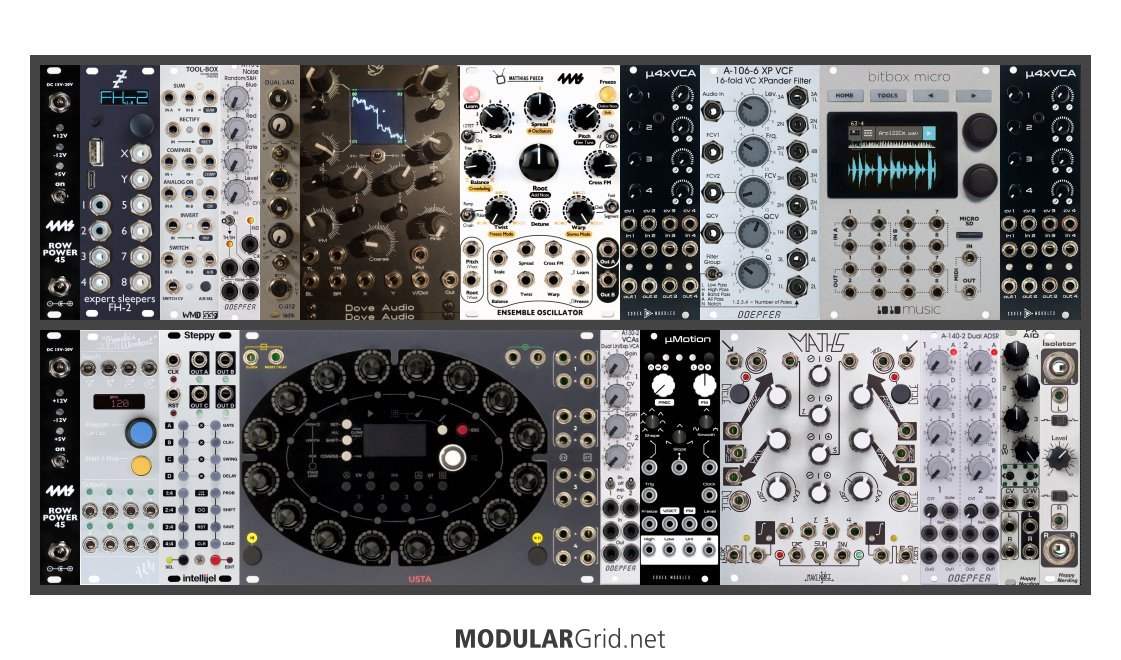The second one. Reason for this is that you can always add some sort of expression controller, especially since you have the FH-2 in there, allowing anything with USB Host requirements to jack right in. This also means that you can use the modular "upright" instead of laying flat, which should improve the ergonomics. As for module complement, the only problems I see are the presence of the Links (this build is too small for dedicated mults...you need to maximize space functionality in these, meaning that it makes more sense in this size to use stackcables or inline mults) and the filter complement, which is just two LPFs, meaning that you're missing out on the potential of any of the other filter topologies.
The workflow here, though...hm...this needs tinkering...

OK...loads of tweaks, as it turned out...but the game is definitely upped.
Upper row is mainly the "voicing", lower is control and modulation...again, mostly.
I changed out quite a few things here. In some case, it was to clear space for essentials (like the noise/S&H and Ladik Dual Lag) and in others, there simply was a better solution (such as the Doepfer VCF...which gives you 16 different topologies which you can also access simultaneously). But loads of additions here...
Top row: power, FH-2, then there's a WMD Toolbox, which has a bunch of little tricks up its sleeve. After this is a noise/S&H, then a dual slew gen with selectable glide-on-direction response. I replaced the Shapeshifter with Dove's new Wavetable VCO, which saved some money and space, and also provides a more straightforward "PPG-ish" wavetable oscillator. Your Ensemble Oscillator is next, then there's a quad VCA (Codex Modulex's clone of the Veils module) and mixer to sum down the oscillators and/or sampler. That Xpander VCF is next...yes, it's Dieter's version of the Oberheim Xpander filter. Then the Bitbox and another VCA/mixer for your final summing; this then goes down to the right end of the bottom for FX and output isolation.
Bottom row: power, Pams's, Steppy, Frap sequencer. Then two more dual-response VCAs, placed specifically for modulation signal processing. Codex's "Tides" clone is next up, followed by the Maths, then there's a dual ADSR which should come in handy for VCF and VCA control. Happy Nerding's new FX Aid gives you Spin FX-1 algorithms in stereo next, and last comes their Isolator, which provides transformer isolation/balancing for better audio and a single master level control for your output.
This seems more solid. For one thing, it has the "little bits" put in that allow the main modules to really cut loose. Functionally, this is WAY more dense and open-ended, and there's loads of "tricks" hidden throughout the build to up the programmability. The sole concern I have now is about the depth, which maxes at 50mm in this version, and the majority (but not all!) of dual 104hp cabs start having trouble at around 45mm. However, you might take a peek at Erica's 2 x 104hp portable case, which offers a 67mm max depth AND a kickass power supply with 2.5A on both 12V rails, and another Amp on +5V. The current headroom, all totalled, would be about an Amp, so the likelihood of overdrawing the P/S is pretty much zero. Also, this would negate the need for the 4ms ROW POWER 45s, so you'd wind up with another 4 hp per row for more twiddling, although at present the build still has these.

